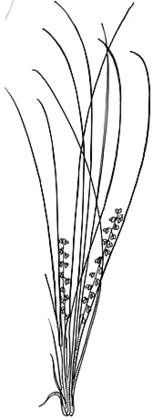Common name: Wattle Mat-rush
Lomandra filiformis (Thunb.) Britten APNI* Synonyms: Dracaena filiformis Thunb. APNI*

Description: Perennial tussock, sparse or occasionally in short, dense mats to 20 cm diam.
Leaf sheath margins eventually lacerated, whitish, occasionally ± intact, purplish brown.
Inflorescence axes smooth, papillose or scabrid; flowers separate. Male inflorescence branched with the branches alternate or occasionally some whorled, or unbranched. Female inflorescence less branched with a short or hidden scape. Bracts ovate, 1–2 mm long; inner bract sometimes absent. Flowers yellow, not usually blackening when dried. Male flowers globose, c. 2 mm long; outer tepals broad-elliptic to ± circular, shorter and more membranous than the thick inner tepals; pedicel to 3 mm long. Female flowers more tubular, 3 mm long; subsessile.
Flowering: chiefly October–November
Distribution and occurrence: Grows in dry sclerophyll forest usually on well-drained often sandy or rocky soils.
NSW subdivisions: NC, CC, SC, NT, CT, ST, NWS, CWS, SWS, NWP, SWP
Other Australian states: Qld Vic.
Text by A. L. Quirico
Taxon concept:
| | Key to the subspecies | |
| 1 | Leaves folded to much inrolled or rarely flat, flexible or rigid, the apex minutely 1–3-pointed; male inflorescence with axes smooth to scabrid | 2 |
| Leaves flat or nearly so, leathery or firm, the apex usually entire (points readily eroded); male inflorescence with distinctly scabrid axes. Leaves flat or nearly so, leathery or firm, usually 15–35 cm long, 2.5–4 mm wide, smooth or scabrid; apex usually entire. Male inflorescence often up to a half as long as leaves, with a few branches; branches often whorled; axes scabrid; scape shorter than rachis, often yellowish. Female inflorescence smaller, and axes often less scabrid. Bracts all small. | subsp. coriacea |
| 2 | Male inflorescence unbranched to well-branched, usually slightly less than half as long as leaves; axes smooth or slightly papillose especially apically; scape often similar to rachis in length; bracts all small; female inflorescence similar to associated male but slightly smaller. Leaves very fine, channelled, folded, inrolled or rarely flat, usually flexible, <10 cm or >30 cm long, 0.5–3 mm wide, occasionally to 5 mm, smooth or rarely scaberulous, especially on margins; apex minutely 1–3-pointed. Male inflorescence sometimes only 2–5 cm long; axes quite smooth, or slightly papillose especially towards apex; scape similar to rachis in length, usually whitish. Female inflorescence similar but slightly smaller. Bracts all small | subsp. filiformis |
| Male inflorescence branched, quarter to a third as long as leaves; axes smooth to scabrid; scape shorter than rachis, sometimes partly hidden by leaf bases; bracts subtending branches of inflorescence large, smaller in size at upper nodes, female inflorescence more condensed than male, as little as one-seventh of leaf-length. Leaves rolled or flat, usually very tough, 30–40 cm long, c. 2 mm wide, smooth to scabrid; apex minutely 1–3-pointed. Male inflorescence c. 3–7 cm long, quarter to a third as long as leaves; axes smooth to scabrid, often yellowish; scape shorter than rachis, sometimes partly hidden by leaf bases. Female inflorescence more condensed, as little as one-seventh as long as leaves. Bracts subtending branches large, white or whitish, smaller at upper nodes
Back to 1 | subsp. flavior |
APNI* Provides a link to the Australian Plant Name Index (hosted by the Australian National Botanic Gardens) for comprehensive bibliographic data
***The AVH map option provides a detailed interactive Australia wide distribution map drawn from collections held by all major Australian herbaria participating in the Australian Virtual Herbarium project.
|


